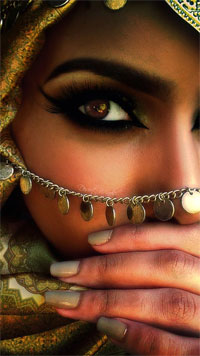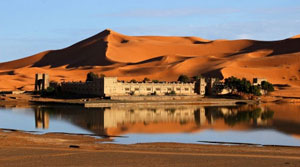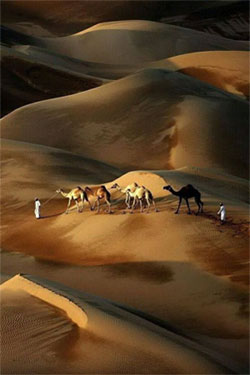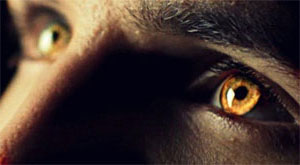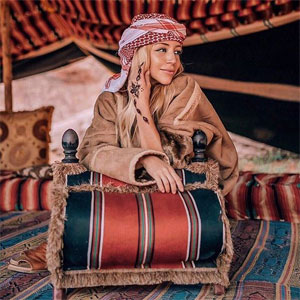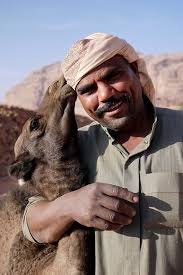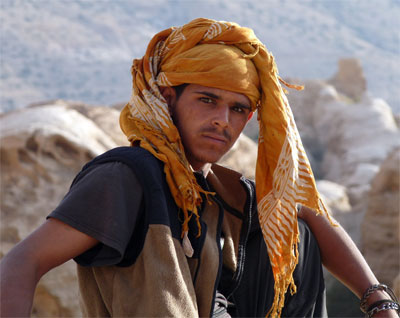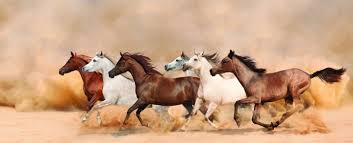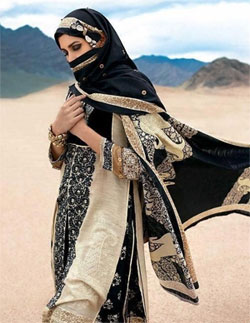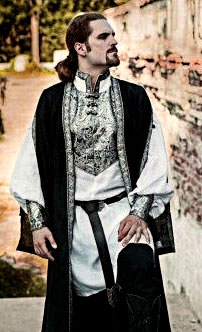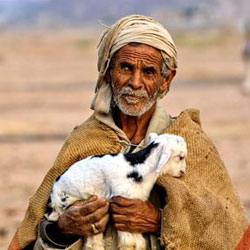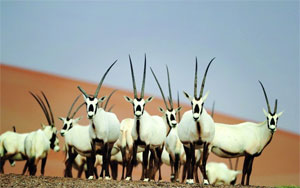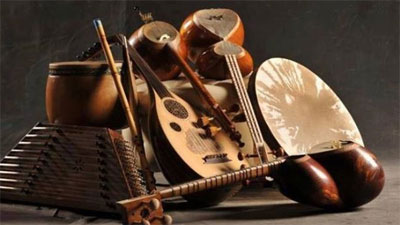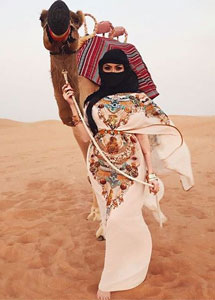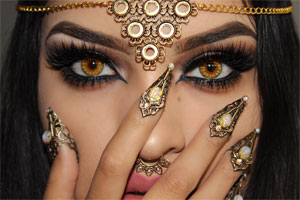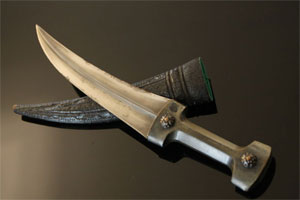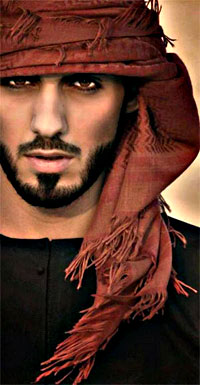Benshira
From Mizahar Lore
The Benshira are the largest group of humans known to Eyktol. Tribal nomads, these individuals are renowned for their survival skills in the desert, their superior animal breeding and care, and for their music which is considered exotic and enchanting throughout Mizahar. And while such pastoral people are often considered easy targets by races that are more known for their skills with weapons, The Benshira make fierce warriors - both male and female - due to the harsh desert conditions and the deadly dangers they face daily in the course of their lives.
These desert nomads have mastered Eyktol and its environment. Learning early on, The Benshira carefully guard their survival secrets in order to ensure their people thrive in the desert unchallenged. They do not often openly welcome outsiders and can be dangerous when encountered by strangers. Because they are endogamous, they marry only within the limits of a local community, clan, or tribe. Marrying outsiders can garner undesirable status in Benshira society. And it is for this reason that there are quite a few homozygous diseases prevalent in the Benshira that might not be found in other races. They are however very open to trading with outsiders for different livestock, raw materials for their crafting, and metals. And while the desert seems devoid of foodstuffs for many other racial groups, the Benshira find food plentiful in the desert and do not often trade for outside sources. They do, however, produce amazing spices and will trade these rare and precious items for far more than their weight in trade goods.
Contents |
History
The Benshira have long lived in Eyktol. No one can remember a time where there were not Benshira there. These clever people have adopted a semi-nomadic lifestyle that if studied thoroughly would reveal that they treat the whole of the region like a giant wagon wheel. Each tribe has a territory, called a Pitai, that forms the space between the spokes. They tend to travel on the rim of the wheel during the blistering hot summers in Eyktol and migrate in towards where the hub of the wheel is located during the rainy season when the desert cools and blooms. Within these spaces between spokes, each individual tribe will have a set migratory path they tend to take which is based on the needs of the people and animals with them. Since there are seven major tribes, that means there are seven major territories.
The Quas
Each tribe has a Quas which is a desert fortress that is rarely inhabited except for a few times a year for holidays and celebration, or during times of great strife or wars. The Quas of each tribe is vastly different from other tribal strongholds and are designed around the unique aspects of each tribe. The location of each Quas is carefully guarded and known only to the members of each individual tribe. These places are not inhabited year round due to the worry of depleting resources around them. However, they are most commonly found at oasis' or in the most resource rich areas within each tribes territory. These Quas are always carefully maintained during the tribe's visits and if something needs repaired or expanded, the tribe might linger at the Quas to make the needed upgrades. Quas are also used as places to retreat to when disease and harsh weather happens.
Some scholars speak that the existence and maintenance of each tribe's Quas speaks to a time long back in history when either the desert could support settled lifestyles or that the Benshira themselves came from settled areas and migrated into the Desert and clung to pieces of their former lives by building and maintaining the Quas. Most Quas are incredibly old, having pre-Valterrian architecture and technology working or not.
Relationships With Eyktol Cities
Because of their nomadic lifestyle, Benshira are often considered prey to those races that will enslave others. Lone groups of Benshira are vulnerable to capture and because of the beauty of their women are often targeted. Children are taken first, of course, for they make the best slaves while adults are often killed outright due to their surly high spirited nature - especially the males. Thus, relationships with outsiders are not often very ingenious or endearing. The Benshira - though gentle among themselves - are fierce with outsiders and protective of their own.
Wadrass
Wadrass is the only known Benshira trade city. It is small in nature, surrounding a very prominent oasis, and has a very small resident population. The Benshira use Wadrass to gather, celebrate holidays among multiple tribes, trade livestock, crafts, and trade goods as well as for people from various tribes to meet and marry into new tribes. There is a small Tiach market there as well. Tiach are ex-members of the Benshira that have been stripped of their tribal status and made into slaves due to crimes they have committed against the Benshira peoples. Wadrass also has a set of prominent temples to the Gods Syna and Yahal. A small priesthood exists there for devoted worshipers among the Benshira. Wadrass has no walls, no boundaries and because of that its location and dimensions shifts with the sands and the changing of the oasis waters. People come and go from Wadrass at all bells of the day. And the city itself has no real governance other than family councils that comprise the Benshira that happen to be at the city when trouble breaks out.
Malrion
The mage city of Eyktol is a source of danger to the Benshira. More often than not, their excess Tiach are purchased in the markets of Wadrass and end up serving in Malrion. The captured children of the Benshira who exhibit mage gifts also tend to end up in Malrion as The Devoted. Benshira are welcome in the city and treated cordially. They are often found plying their wares in the Market and Malrion’s Devoted, female mages at the top of the city’s society, include a handful of Benshira among their ranks. As with anyone who lives in or visits Malrion, Benshira must take great care of how they display or speak of anything tied to religion else risk breaking the Magelord’s strict laws governing such things.
Other Cities
Endrykas sometimes comes into contact with Benshira who live on the northern boarders. Relations with the Drykas are fairly open and tend to work out well. The Drykas are perhaps some of the only outsiders that may be welcomed in Benshira tribes for extended visits. These relationships may speak of historical common ancestry, though there are no records yet discovered surviving the Valterrian that can verify these suspicions.
The Benshira Tribes do trade with the Svefra on the fringes of their territories during the heart of the Summer. Many tribes of these nomadic peoples can be found in coastal encampments along the shores of the Suvan Sea and Western Sea respectfully. Summer for the Benshira often involves fishing and gathering at such locations, though the coasts of Eyktol are less rich in resources than the coasts of more northern milder climates like Cyphrus and Sylira.
Other cities in Eyktol and beyond will be added to this write up as their rewrites and developments go forward.
Biology
Physical Appearance
The Benshira are one of the smaller races in Mizahar. They are not quite as diminutive as the Inarta, but straight humans definitely can easily grow taller and heavier. Their skin is a golden olive that protects them from the sun. It tends to darken with exposure and rarely burns unless extreme situations or ill health have affected the individual. Hair color can vary widely with the most common being black or dark chestnut brown. However, blondes and redheads are not unheard of either. The one unifying trait to the Benshira are their eye shape and color. Benshira have wide large eyes that are a distinctive trait among them. They enjoy deep richly colored eyes ranging from a brown so dark it looks black to a vibrant golden gaze that is almost reminiscent of the burning orb of Syna in the sky. The vast majority of Benshira have eyes that can be described as Topaz or Gold, though Hazel sometimes crops up. A pureblood Benshira with blue, green, or blue-green eyes is almost never heard of, though when it happens they tend to have a hard time among their people - considered unlucky and often get exiled or excuses are used to quickly gain them Tiach status.
Common Traits
Because The Benshira are endogamous, inbreeding can become a problem though their gathering at Wadrass for tribal trade in goods and young people via marriage has done a lot to augment these issues. The noted lack of influx of fresh blood has left a people who are prone to certain problems. They have a noted smaller adult size, reduced birth rate, reduced fertility, higher infant and child mortality, reduced immune functions, higher rates of heart disease and far more common occurrence of genetic disorders than most races. As medicine advances on Mizahar, these issues are coming to light among the very traditionalist Benshira and there are younger generations that are trying to smooth the way to bringing in outsiders to augment their numbers, increase their knowledge of outside skills, and overall improve the bloodlines. Oddly enough the Tiach among the Benshire often don't suffer these issues since they often interbreed with outsiders and have larger healthier children with higher birth rates.
The Benshira enjoy an astonishing connection to their animals, the desert, and each other. Outsiders have often noted the way The Benshira are with animals often could be classified as Preternatural in nature or even perhaps magical. The Benshira make no claims to lost discplines of animal magics, though if they indeed possessed such knowledge, it would never leave the tribes.
Psychology
The Benshira have a rare mixture of kindness and ferocity in their nature. They are incredibly loyal and honorable in their endeavors, and understand that they have to rely on each other for survival in the desert. Their laws are strict but fair, and their family units are often nurturing though they are fairly hands on and the schooling of children comes early. Benshira pride themselves on the truth and in not telling it, they believe they will suffer ill luck and fortune. Their trades are often fair and their work for wages given an honest effort. Children work from an early age, almost as soon as they can hold a tool even if its just gathering up dung to burn on the fires or making sure animals are watered. A strong ethic is ingrained in the young of the tribes early and they are taught oral traditions and the stories of their people from birth.
Reproduction
Benshira are polygamous, however their polygamy is earned not a given. Males rule the household and will marry as early as eighteen years of age. They are considered men at fifteen, but often have adult responsibilities from twelve years of age on. The wealth of a family is measured in the skill of the patriarch at a craft, animal husbandry, or his prowess with a blade. Because the Benshira have a lower birth rate and sometimes fertility issues, the value of a woman varies slightly from that of a man. If a woman is of child bearing age, she is married. Girls as young as thirteen can be married off, knowing the sooner and the earlier they have children, the more likely those offspring are going to be to survive. The more prowess a woman has at a craft or a blade, even a skill such as healing, the more desirable she will be to take as a wife. These are traits that are considered highly inheritable by the Benshira who often seek to strengthen their families and ultimately the tribe. If a woman has been married for more than a year without bringing children to a marriage, she can be released by the husband and is free to marry again. If the husband is proven to be the issue by taking multiple wives, those women can be released by the tribal elders from the marriage to marry elsewhere to someone who can give them children.
Males can marry once at any skillset or wealth level, though their choices will increase with the increase of wealth. Women are not forced to marry, though it is culturally expected of them and they have their choice of males. Obviously, wealthier males who are better providers are more appealing than impoverished males with little to no skill or material possessions. However, males can take a second wife if they master a second skill and thus are considered wealthy enough to support such a thing. Current wives have no say in the acquisition of additional wives. Wealth in the tribes are often measured by the number and health of a herd, the number of children and health of those children in a family, and the ability of the adults to provide for and defend their families.
Society
The Tribes of The Benshira are divided into seven groups with each group having a specialty sort of animal they specialize in raising and breeding. Each group can have multiple animals such as sheep, goats, horses, donkeys, oryx, ostriches & taurida, or even sun cattle. However, only a specific tribe is known for their exceptional raising of these individual breeds and are considered 'the best' stock of the Benshira. All tribes keep fowl of multiple sorts for their meat. All Benshira keep dogs for the guarding and herding of flocks, even those known for their non-herding livestock.
All tribes teach a wide variety of skills, offering apprenticeships and opportunities for people to learn. Magic is not taboo among the Benshira so a wide variety of the magical arts is also taught among tribes. No one tribe is overly skilled in any single magic or craft unless it is mentioned below along with the individual tribes' animal specialty. Individual families are not listed within the tribes because multiple branches of the same family can exist across multiple tribes.
The Kois
The Kois Tribe is noted for their breeding of Desertbred horses. They have the swiftest strongest horses in Eyktol and thus have the second largest territoy second only to the Lisuli who can travel further with their camels than any of the other Benshira Tribes. The Kois are also known for their singers. Almost everyone in the tribe singings, and when they have entered conflict with other tribes and have engaged in battles, their battle songs are legendary.
The Lisuli
The Lisuli Tribe breeds a wide variety of camels for the entirety of the Benshira. They have racing camels, long distance traveler camels, and camels that can pack their weight or more on their backs for days across the desert without water. For this reason, the Lisuli tend to travel with more things over the longest distances in Eyktol since they have dray camels that are designed for such work. The Lisuli are incredible weavers as well and its often noted that their animals, tents, and indeed people are decked out colorfully in an almost garish manner.
The Rhagha
The Rhagha are the sheepherders of Eyktol. They can produce more meat on almost no grazing than any other Tribe. They are often in conflict with other tribes in areas that the tribes share land with for the way their sheep crop the ground - pulling roots and all from the ground - rather than simply nipping off the green edible parts of a plant - cause the rest of the tribes to rather dislike them and often blame them (not without reason) for the devastation of bits of land they linger too long on. The Rhagha are masters of felting due to their inexhaustible supply of wool. They make their clothing of felt and most of their tents and furnishings are made of felt. The felt the Rhagha make are in high demand and get a premium price at markets worldwide. In addition to sheep, the Rhagha are known for their tough desert donkeys that they raise among the sheep for the protection of the sheep against jackals and wolves.
The Beldra
The Beldra are an interesting Tribe. They raise Sun Cattle, which are enormous semi-intelligent beasts with hides of burnished gold, coal, bronze, and copper. Sporting large horns that sweep back and upwards, the horns of the Sun Cattle help the animals cool and keep them relaxed in the heat of the desert. Sun cattle can pull wagons and be used as a pack animal. The Children of the Beldra often ride them as well, finding them sturdy mounts when the tribe is on the move. Because of their cattle, the Beldra are well able to travel as far, though not as fast, as other more mobile tribes. And they can indeed carry more with them. Most of the blacksmithing done among the Benshira is done via the Beldra Tribe. They make fine weapons, armor, and any sort of metal fastener or tool one might need to use.
The Danisa
The Danisa raise ostriches and taurida, and are famous for hosting races of such creatures. The Taurida are bigger birds than the ostriches and can be ridden much like horses. Ill tempered, both the ostriches and taurida are dangerous to those not used to handling them. They provide meat and eggs to the Dansia and are oddly one of the only tribes to farm these animals due to their ill temper. The Danisa often keep milk animals, but will not tolerate chickens in their ranks due to the aggression of the larger birds. They do not keep horses either, since the two species tend to not get along well. Renown potters, it is thought the Danisa add ostrich and taurida shell to their glazes to get astonishingly beautiful glazes on fired pottery. Throughout Eyktol, hidden deep in Danisa territory, are a series of kilns the Danisa have built and use as they migrate back and forth across Eyktol.
The Selban
The Selban are a somewhat smaller more mysterious tribe of the Benshira. They tend to have paler hair, often times almost white, that is said to match the livestock they raise. Oryx, large fleet desert antelope are what the Selban specialize in. They provide meat, cheese, milk, and blood to the Selban. Because of their rideability, the Oryx can give the Selban the classification of the ghosts of the Benshira. This tribe can travel fast and light, living with very few possessions, and can materialize and vanish in the desert at will. The Oryx have a unique ability to leave no tracks as they pass which adds to the mystic of The Selban tribe which are near impossible to find unless they want to be found. Within this tribe, the women are more prone to be the warriors, often chosen by the Oryx to be riders due to their lighter weight and improved finesse in the saddle. But despite the warrior tendencies of the Selban, this tribe is also known for making amazing instruments and drums. Some of the best musicians in Benshira history are Selban.
The Nitai
If ever there was a stereotypical tribe of the Benshira, it would be the Nitai. These herders have very few horses and sun cattle, instead preferring to live with their beloved goats and walk afoot almost everywhere they go. They prefer the speed of their goats, and live a very simple devote lifestyle. They own what they can carry on their backs, having small tents and limited resources. However, it is thought that the Nitai Benshira know the deserts of Eyktol far better than any other race, even the other tribes of their own. Because of their simple lifestyles, however, the Nitai are more vulnerable than other tribes and often have fewer warriors. Because of this fact, it is not uncommon for Nitai to join with other tribes for short periods of time as the tribes migrate around. And it is more than true if a Benshira has a need to disappear, they can find sanctuary among the Nitai regardless of what tribe they originally are from. The Nitai are said to be the keepers of the oral histories of the Benshira and the most devote among the tribes.
Social Structure
As touched on earlier, the Benshira as a whole is an umbrella term used to describe the loose organization of seven tribes of desert nomads in the Eyktol region. These seven tribes are further divided down into families that share a common tent or grouping of tents. Families are further broken down into a Patriarch which beneath resides his wife or wives, then their children, and then their guests, servants, and tiach. Wives have a hierarchy not dependent upon order of marriage but based on how many healthy children they produce. Children are usually lumped together though age factors into the chores assigned and the importance of the child to the family. Animals are treated according to the hierarchy enjoyed by the families they belong too. The tribes themselves have no hierarchy over each other. They are simply experts in their fields. Each Tribe is lead by the eldest male (still able too) in the tribe who is drawn form the eldest male leader of each family. When the tribes get together, the tribal leaders will meet, but a larger gathering of family leaders will also meet.
When the tribes travel, not all families travel together. Family groups can split off and spread out the grazing of their herds. Unlike the Drykas, they do not move every three or four days. Instead, the tribes move when the grazing is depleted, and tend not to follow any particular pathways other than moving inwards as winter falls and moving outwards from the center of Eyktol when summer is upon them.
Language
The Benshira speak the Shiber language. Shiber is a very musical lyrical language that has a poetic cadence to it that lends itself to song. Some of the most beautiful songs in the world are sung in Shiber and get translated later to Common. Shiber has a written component as well which is an alphabetic rather than pictorial sort. The Benshira keep their written records on wadj, which is a paper made from desert plants that is particularly sturdy in the heat. Caches of Benshira records lie all throughout Eyktol, hidden away so the tribes do not have to carry them. There is a small library in Wadrass that houses some of the more important and popular writings of the Benshira.
Names
Within the Benshira, each individual person has three names. The first given name is how the individual is identified. The middle name is the representation of their genetic linage within any given tribe. The last name always honors the tribe and their tribal identity. When a person is stripped of their place in the tribes and turned Tiach, they loose the right to use their middle and last names.
Each member of the tribe takes on the tribal name as their last name. This name will be whatever tribe they reside with so long as they reside with that tribe. If they change tribes for whatever reason, then they must assume that new and current tribe as their last name. Their middle names are the family linage names. So a woman named Kalstami Sumara Lisuli is of the Lisuli Tribe, but her parents were both Sumara Lisuli's. If she marries, say into the Kois tribe, her name will change to Kastami Sumara Kois or to whatever tribe her husband belongs too. Her children's middle name will be her husbands middle name, since the Benshira are patrilineal. If Kastami married another Kois - which is likely, her name would not change upon her marriage. The Sumara family could reside across multiple tribes so there could be branches in the Kois, Lisuli and other tribes simultaneously.
Given names are decided by both the parents of the offspring. Children born outside of marriage are given the middle name of Ommos - meaning bastard - with a tribal name of whatever tribe they were born too. Ommos children and adults carry the stigma with them always and are often considered undesirable folks for wedding matches unless they are incredibly skilled. Ommos children also find apprenticeships with craftsman, in the trades, and even with healers or animal handlers hard to come by. They are often forced to work menial labor and are often treated somewhat worse than tiach, which are often considered valuable members of a tribe.
Everyday Family Life
Life in the Benshira Tribes is simple and consists of work, more work, and even more work. From sunrise to sunset, the Benshira family units will work to hunt, herd, gather food, and protect their assets. At night, the herds are usually driven into the center of the circle of family tents that a traveling group of a specific tribe had and then watched by older children and livestock dogs throughout the night. In the evening, a group meal is served and there is often song and dance to end the day.
Every day when the sun is high overhead, Benshira often take a full bell to pray to their chosen gods and to perform meditations and silent prayers between the 1130 and 1230 bells. Naps are not frowned upon during the hottest part of the day in the summer, though in the winter those same periods of rest will be used for periods of study. Benshira tend to the education of their children and take lessons very seriously. Often, one woman - usually barren - is the teacher in the tribe and will school all the children together. It is also not unheard of for a wounded warrior or herder who cannot ride or herd any more to assume similar duties.
When guarding livestock, it is not uncommon for Benshira youth to practice their weapons, race their horses, or challenge their dogs. They enjoy games involving Benshira sports, and often will compose poetry or songs to sing or speak to their loved ones. Benshira culture is rich and they keep themselves busy. Empty or listless hands are often put to use immediately, even if it is just to chop vegetables or to clean clothing. The older and more studied a Benshira gets, the more they will devote their time to their profession and less time to chore type situations.
Art and Industry
Being nomads, the Benshira don't get mired down in city life too often unless they are stopping in Wadrass for trade reasons. This gives them far more time than one might suspect, being out in the desert even with limited access to raw materials, to practice inventive crafting. As a result, they have channeled many of their creative aspects into art. They leave nothing without decoratation. Simple flatware will often be elaborately etched. Dinnerware will be painted elaborately. Hems of shirts and cuffs of sleeves are rarely without embroidery. Even the development and wearing of cosmetics for women is an art among the Benshira. They do it for the love of art. They do it as a form of worship to their deities. Syna is honored on the bridles of horses in the form of elaborately tooled sunbursts. Yahal is honored in a million feathered fringes on the edges of stockings. Leather bags, vests, even gloves are adorned with images of family, symbolism of tribes, and the merits of the power the item holds. For the Benshira believe that everything has power, its just a matter of tapping it. And they've made a grand trade of this belief.
Benshira crafted music, instruments, leather workings, and even trained animals are all sought by the outside world. The best of the best, the Benshira keep to themselves. But anything they consider cull worthy can be traded. So even though the outside world covets their art and the results of their science, the outside world never sees the true beauty of the Benshira because they withhold it for themselves. They have jewelers and other unusual masters like weaponssmiths among them.
Weapons
The Benshira enjoy numerous weapons, much like the rest of Mizahar. They are particularly adept at spears, axes, and curved swords or daggers. Scimitars are a favorite, as are bows that give the Benshira more distance. Herders are particularly skilled at whips, though they rarely use them on animals. A typical bull-whip wielding Benshira is often skilled enough to take out an opponents eye at the reach of the whip with a flick of their whip. Women among the Benshira have a secret weapon they love using. They love wearing decorative metal tips on their fingers which are often razor sharp and can be used as weapons in hand to hand combat. These fingertip blades are decorated to look like elaborate jewelry, though they are deadly. The Benshira call them Fias meaning 'claws' in Shiber and almost always teach their daughters to use them from an early age.
Religion
Primarily worshiping Yahal, Rhaus, Tyveth, and Syna, the Benshira honor their Gods and Goddesses daily. They are well aware that their deities walk among them as their legends are full of the stories of such visits. Other Gods and Goddesses are known and worshiped among the Benshira, though they hold a special place in their heart for the quadrad as they call them. Being Syna's Consort, Leth is also acknowledged and worshiped, as most of their family gatherings take place beneath his light. Akajia is prayed to as the Night Mother to hold their herds safe through the night. Enemies of their chosen Gods and Goddesses have become The Benshira's enemies. Rhysol particularly hates the Benshira due to their passion for order and discipline and targets members of their race whenever he can. When a Benshira does something to his kind or to damage his faith - such as sack one of his temples - there will be no mercy and no forgetting the slight in the eyes of the deity.
There are many other Gods and Goddesses that are welcomed among the Benshira. Rak'keli with her healing and Makutsi with her rain. The Benshira still mourn the fall of Aquiras - for they are the people of travel. As such, Sagallius is one of their immortal enemies. They love Semele like a mother and step barefoot on her soil daily to honor her. Zulrav is honored and feared due to the rolling sandstorms he can bring. The Benshira honor life, death, and all the things in between. They are deeply reverent and it has not been unheard of for one of the Gods to live among them for years, learning and experiencing life as they experience it. For even the Gods understand that the Benshira's life is hard, but beautiful and sometimes they covet - if only for a little while - what mortals do.
Race Relations
Please be aware its not easy for Benshira to allow strangers into their communities. It is always a very special circumstance that a non-Benshira would live among the Benshira. That being said, the Benshira do have opinions on other races.
- Akalak: These warriors are often welcomed among the Benshira for short times. The Benshira as a whole are unaware of their dual nature, but they respect the Akalak due to the religions both of them have in common.
- Akvatari: While finding them somewhat melodramatic and depressing, the Benshira recognize Akvatari as fellow artists. They just wish they were a little more cheerful in their endeavors and thus avoid them if at all possible.
- Chaktawe: Virtually extinct, the Benshira view the Chaktawe as drains on their own precious resource and normally conflict arises between the two groups.
- Charoda: This aquatic race is virtually unknown in Eyktol and there are no relations with the Benshira due to the heat.
- Dhani: Of all the non-human races, the desert dwelling vipers and rattlers are the most welcome among the Benshira.
- Ethaefal: Thought of as strange and celestial, Benshira treat them with distance and respect. However, if their ‘normal side’ is a race feared or hated such as Symenestra or Zith, they will be executed as soon as this fact is discovered.
- Eypharian: Thought of as arrogant, this race is unwelcome in the tents of the Benshira since they tend to like to enslave the Benshira.
- Ghost: The Benshira have an inate dislike of ghosts. They feel ancestors must move on and not linger bringing dishonor and bad luck.
- Humans: Humans are always treated with caution for no two are alike.
- Drykas: Respected neighbors and honored guests, especially in the north.
- Inarta: Rarely seen in Eyktol, they are treated as exotic normal humans.
- Mixed: Generally treated the same as straight humans.
- Svefra: Heavily trade with the Benshira during the summer when they are on the coast.
- Vantha: Almost unheard of in Eyktol, they are unknowns to the Benshira.
- Isur: Isur are rare in Eyktol and have an almost legendary status among the tribes. The Benshira do tell stories of the Mountain Kingdoms.
- Jamoura: The Benshira have had almost no contact with this rare race in Eyktol and have no opinions on them.
- Kelvics: Falling into the same category of their livestock, Kelvics are perhaps the only race fully welcomed into the tents of the Benshira.
- Konti: Welcomed as revered healers and seers. They are discouraged from traveling deep into the desert but often if one is lost or freed from slavery she will be escorted to the coast by the Benshira.
- Mixed Blood: See each part of the combination for reaction. Part Syms and Part ziths fall under full blooded status for the purpose of the Benshira's viewpoint and these individuals are executed on sight.
- Myrians: The ethics and societal values of the Myrians conflict heavily with the Benshira so the resulting entanglements rarely end without bloodshed.
- Nuit: Killed on sight.
- Pycon: Considered magical and unpredictable, the Benshira don't see Pycon as a true race.
- Symenestra: Males are slain on sight. Females are escorted from Benshira territory immediately.
- Zith: Hunted and killed on sight.
Active Benshira PCs
| The Desert's Honorable Children | ||
| Abashai | Benshira Warrior In Exile | |
Informative Threads
| Information threads | ||
| The Benshira Question And Answer Thread | Gossamer answers questions on the new Benshira Writeup. | |

